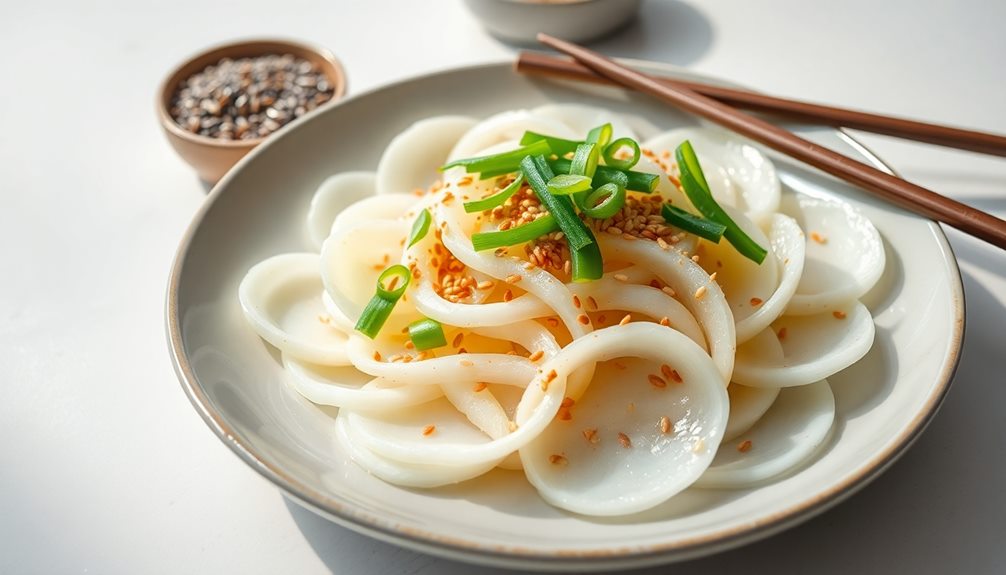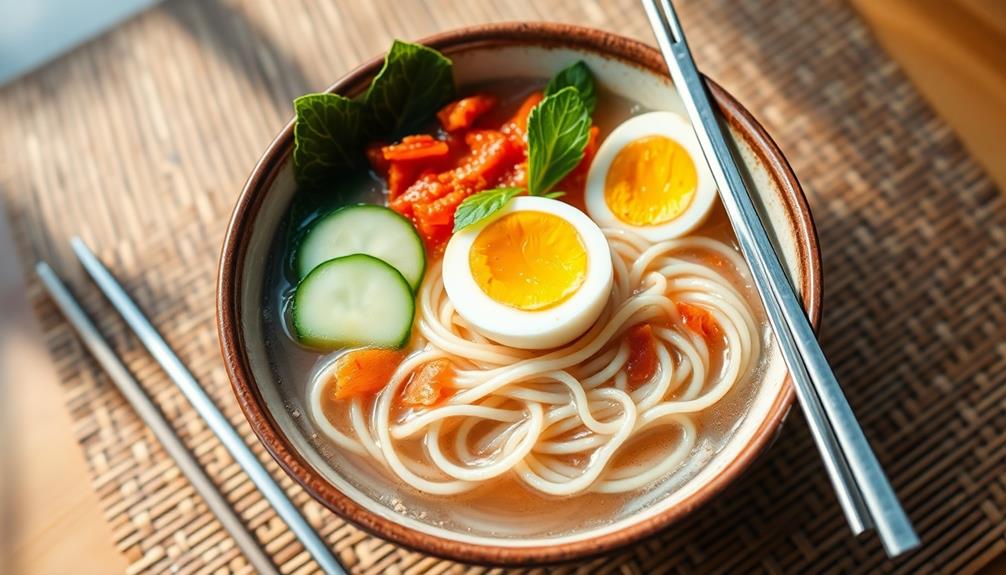Bibim naengmyeon, or spicy cold noodles, is a Korean dish that's super fun to eat! It features chewy buckwheat noodles tossed with a spicy and sweet gochujang sauce, along with colorful veggies like cucumber and carrots. You can even toss in sliced eggs or pickled radish for extra flavor. After cooking the noodles, chill them in ice water to make them extra refreshing. This dish is perfect for hot summer days and is a popular choice for celebrations. So, if you're up for a tasty adventure, you'll discover even more about this delightful meal!
Key Takeaways
- Bibim naengmyeon is a refreshing Korean cold noodle dish, popular during hot summer months, known for its spicy-sweet sauce.
- Key ingredients include chewy buckwheat noodles, gochujang, vinegar, sesame oil, and a variety of fresh vegetables.
- The dish symbolizes resilience and creativity, often served during special occasions like birthdays and celebrations.
- Customizable with toppings like sliced eggs, beef, or pickled radish, it offers a balance of flavors and textures.
- Chilling the noodles in ice water enhances their chewiness, making bibim naengmyeon an enjoyable summer meal.
History
Bibim Naengmyeon's origins trace back to Korea's post-war era, where the need for a refreshing dish became paramount. After the Korean War, people wanted something tasty and cool to enjoy, especially during hot summer days. They created this delicious cold noodle dish, mixing chewy buckwheat noodles with spicy sauce, crunchy vegetables, and sometimes even a boiled egg on top. Doesn't that sound mouthwatering?
As the dish gained popularity, it became a beloved staple in many Korean households. You might be surprised to learn that Bibim Naengmyeon isn't just a meal; it's a symbol of resilience and creativity! Families began adding their unique twists, experimenting with flavors, and making it their own.
Today, you can find Bibim Naengmyeon at restaurants, and it's often featured during special occasions like birthdays and celebrations. People enjoy it not just for its flavor but also for the fun of mixing everything together before digging in!
Recipe
Bibim Naengmyeon, a delightful Korean cold noodle dish, is perfect for hot summer days or whenever you're in the mood for something refreshing yet satisfying. The name "bibim" translates to "mixed," which is fitting as the dish features chewy buckwheat noodles topped with an array of vibrant vegetables and a spicy-sweet sauce.
Traditionally served cold, this dish isn't only visually appealing but also packed with flavor, making it a popular choice among both locals and visitors alike.
To prepare Bibim Naengmyeon, you'll need a selection of fresh vegetables and a well-balanced sauce that combines gochujang (Korean red chili paste), vinegar, and sesame oil. The noodles are often garnished with sliced egg, cucumber, and sometimes even beef or pickled radish, bringing a variety of textures and tastes to the plate.
This dish is versatile and can be customized based on your preferences or seasonal ingredients, ensuring a unique culinary experience each time.
Ingredients:
- 200g naengmyeon (cold buckwheat noodles)
- 1/2 cucumber, julienned
- 1/2 carrot, julienned
- 1 hard-boiled egg, halved
- 100g sliced beef (optional)
- 2 tablespoons gochujang (Korean red chili paste)
- 1 tablespoon vinegar
- 1 tablespoon sesame oil
- 1 tablespoon sugar
- 1 teaspoon sesame seeds
- Chopped green onions for garnish
- Ice cubes for serving
To cook Bibim Naengmyeon, start by boiling a pot of water. Once boiling, add the naengmyeon noodles and cook according to the package instructions (usually around 4-5 minutes).
Once cooked, rinse the noodles under cold water to stop the cooking process and to cool them down. Drain the noodles well and place them in a bowl. In a separate bowl, mix the gochujang, vinegar, sesame oil, and sugar to create the sauce.
Pour the sauce over the cooled noodles and mix thoroughly. Arrange the julienned cucumber, carrot, and sliced beef (if using) on top of the noodles, and garnish with the hard-boiled egg halves, sesame seeds, and chopped green onions. Serve with ice cubes for extra chill.
When making Bibim Naengmyeon, feel free to adjust the spice level according to your taste preference. You can add more gochujang for heat or substitute it with a milder sauce if desired.
Additionally, the dish can be made vegetarian by omitting the beef and adding more vegetables or tofu. For an extra refreshing twist, consider adding a splash of cold water or broth to the sauce for a lighter texture. Enjoy your homemade Bibim Naengmyeon!
Cooking Steps
Let's get ready to whip up some delicious Bibim Naengmyeon!
First, you'll prepare a refreshing cold noodle broth, then layer in colorful vegetables and tasty toppings.
After mixing those noodles with a spicy sauce and chilling everything in ice water, don't forget to sprinkle some sesame seeds on top for that perfect finishing touch!
Step 1. Prepare Cold Noodle Broth
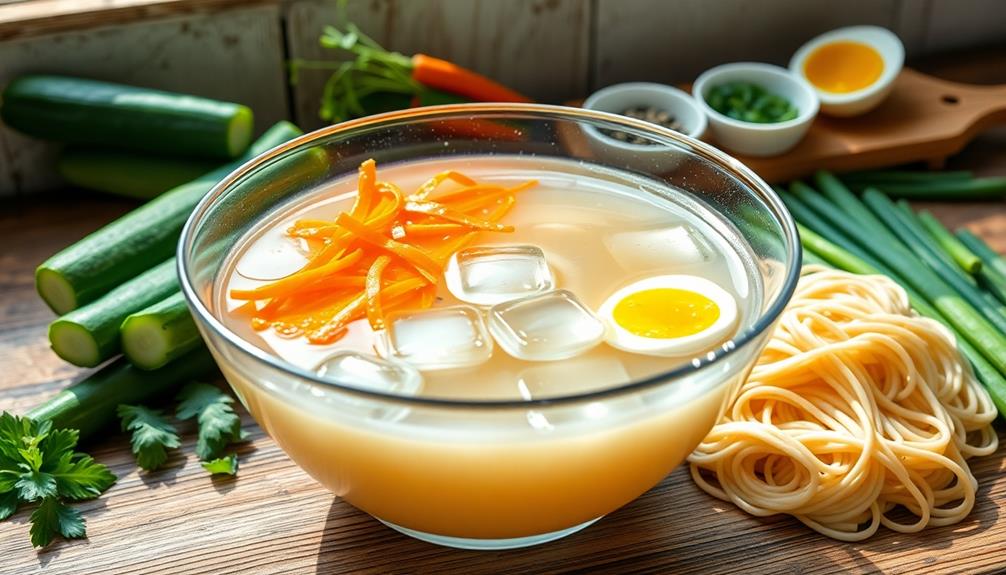
To kick off the preparation of your cold noodle broth, gather all the essential ingredients first. You'll need water, soy sauce, vinegar, sugar, and sesame oil.
Once you've got everything, it's time to get cooking!
Start by pouring about four cups of water into a pot. Turn on the heat and bring it to a gentle boil.
While you wait, grab a bowl and mix together three tablespoons of soy sauce, two tablespoons of vinegar, one tablespoon of sugar, and one tablespoon of sesame oil. Stir it well, and watch how the sugar dissolves like magic!
Once the water's boiling, carefully pour in your delicious mix. Let it simmer for about five minutes. This is where all those amazing flavors come together, creating a broth that's both tangy and savory.
If you want a little extra kick, feel free to add a pinch of red pepper flakes!
After five minutes, take the pot off the heat and let it cool down.
You've just made a fantastic cold noodle broth, and now it's ready to chill in the fridge. Your taste buds are in for a treat!
Step 2. Add Vegetables and Toppings
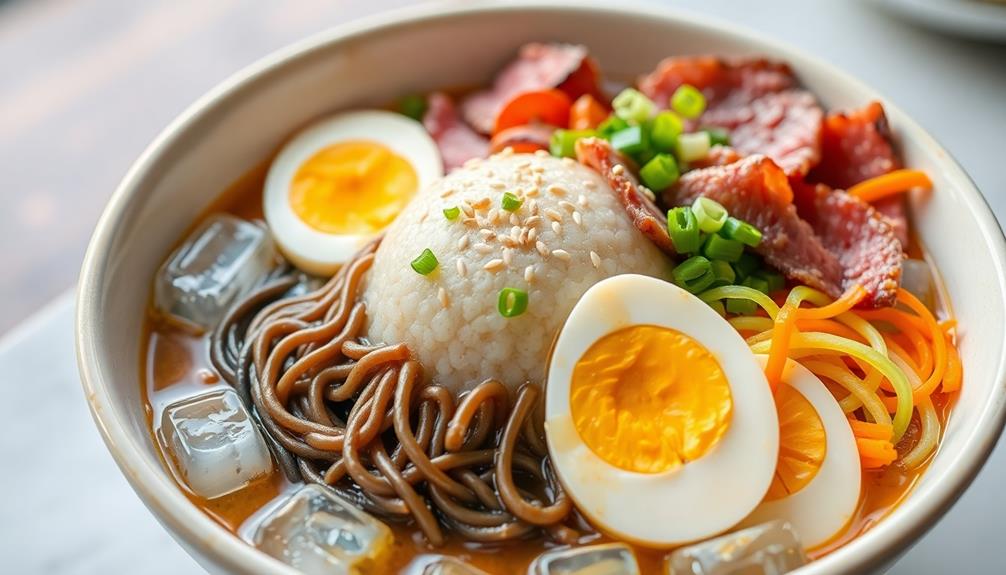
Next, grab a variety of fresh vegetables to elevate your bibim naengmyeon. You can use ingredients like cucumber, radish, and carrots to add crunch and color, making it a visually appealing dish. Fresh vegetables not only enhance the flavor but also contribute to health benefits, similar to how herbal teas can aid digestion.
Start by slicing the cucumber into thin strips, just like making little noodles! Then, julienne the radish and carrots into matchstick shapes. It's like creating a colorful rainbow on your plate!
Don't forget to add some leafy greens. You can use lettuce or spinach, which will give your dish a nice, fresh taste. Tear the leaves into bite-sized pieces, so they're easy to mix in later. If you're feeling adventurous, throw in some sesame leaves for an extra kick of flavor!
Now, consider adding some protein to make your meal more filling. Sliced boiled eggs sit beautifully on top, or you could use some cooked beef or tofu for a tasty twist.
Step 3. Mix Noodles With Spicy Sauce
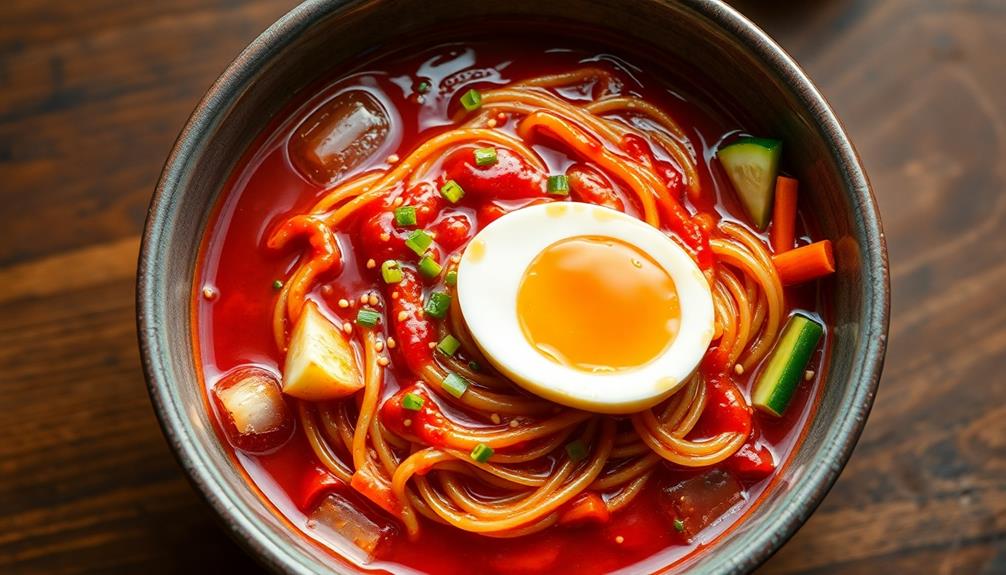
Start by cooking the naengmyeon noodles according to the package instructions until they're tender yet chewy.
Once they're done, drain the noodles and let them cool for a moment.
Now, it's time for the fun part—mixing the noodles with the spicy sauce!
Grab a large mixing bowl and add your cooled noodles.
Then, take your spicy gochujang sauce and pour a generous amount over the noodles. You can adjust how spicy you want it; a little goes a long way!
Next, add a splash of soy sauce, a drizzle of sesame oil, and a teaspoon of sugar to balance the flavors.
Now for the mixing! Using chopsticks or tongs, gently toss the noodles and sauce together.
Make sure every strand gets coated with that delicious, spicy goodness.
If you like, you can add some sesame seeds at this point for a little crunch and extra flavor.
Keep mixing until everything is perfectly blended.
Step 4. Chill Noodles in Ice Water
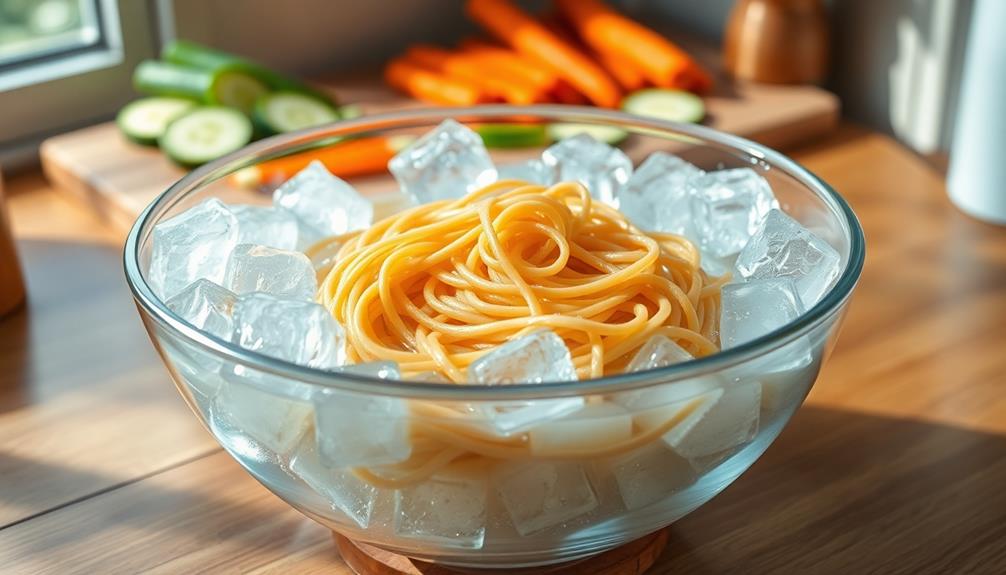
Chilling the noodles in ice water is a crucial step to achieving that refreshing texture in bibim naengmyeon. Once you've mixed the noodles with your spicy sauce, it's time to give them a cool bath!
Grab a large bowl and fill it with cold water and plenty of ice cubes. You want it nice and frosty, just like a winter wonderland for your noodles.
Carefully transfer your cooked noodles into the ice water. Make sure they're completely submerged, so they cool off quickly. Let them hang out in that chilly water for about five to ten minutes. This step not only cools the noodles down but also helps them firm up, giving you that perfect chewy bite.
While they're soaking, you can do a little happy dance because you're one step closer to a delicious meal!
After they've chilled, drain the noodles in a colander, but don't forget to give them a gentle rinse under cold water. This helps wash away any extra starch, ensuring they're nice and slippery. Once the noodles are rinsed, they are now ready to be used in your favorite chilled noodle recipes. These recipes often include a mix of fresh vegetables, protein, and a flavorful dressing to create a refreshing and satisfying dish. Chilled noodle recipes are perfect for hot summer days and make for a delicious and light meal option.
Now, you're ready to create the ultimate bibim naengmyeon masterpiece!
Step 5. Garnish With Sesame Seeds
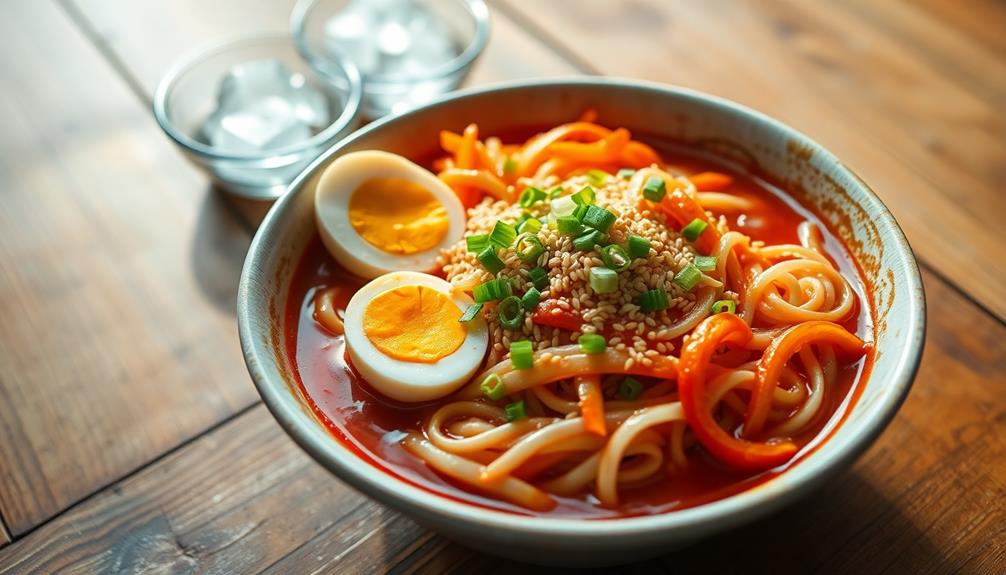
Once your noodles are perfectly chilled and rinsed, it's time to add that finishing touch with sesame seeds. These tiny seeds pack a big flavor punch and make your bibim naengmyeon look super fancy!
First, grab a small bowl and pour in about one to two tablespoons of sesame seeds. You can use either toasted or raw sesame seeds, but toasting them just a bit brings out an even more delicious flavor.
Now, sprinkle the sesame seeds evenly over your beautifully chilled noodles. Don't be shy—let those seeds rain down like confetti at a party! This step not only adds a delightful crunch but also gives your dish a lovely, nutty aroma.
If you want to get creative, try mixing in some finely chopped scallions or a few slices of cucumber for extra color and flavor. It's like giving your noodles a little outfit makeover!
Once you've added your sesame seeds and any other fun toppings, give everything a gentle toss to mix it all together.
Now, your bibim naengmyeon is ready to serve, and you'll be the star chef of the day! Enjoy your tasty, cool creation!
Final Thoughts
When you take a moment to reflect on Bibim Naengmyeon, it's clear that this dish is more than just a meal; it's an experience that captures the essence of Korean cuisine.
Imagine twirling those slippery noodles around your fork, feeling the spicy sauce tickle your taste buds with every bite. You can almost hear the crunch of fresh vegetables as you mix them in, creating a colorful and delicious masterpiece on your plate!
This dish is perfect for hot summer days when you want something cool and refreshing. You can customize it with toppings like sliced cucumbers, hard-boiled eggs, or even some juicy pear for a sweet surprise!
And don't forget the sesame seeds—sprinkling those on top adds a nutty flavor that makes it even better.
Frequently Asked Questions
What Are the Main Ingredients in Bibim Naengmyeon?
When exploring a dish, you'll find that key ingredients often include noodles, vegetables, and a spicy sauce. Each component plays a role in creating a balanced flavor profile that tantalizes your taste buds.
Can I Substitute Noodles if I Can't Find Naengmyeon?
If you can't find naengmyeon, you can substitute with other noodles like soba or vermicelli. Just make sure to adjust the cooking time and rinse them well for a similar texture. Enjoy your dish!
Is Bibim Naengmyeon Gluten-Free?
You'll want to check the ingredients when considering gluten-free options. Traditional recipes use wheat-based noodles, so they're not gluten-free. However, you can find alternatives made from sweet potato or buckwheat for a gluten-free meal.
How Spicy Is Bibim Naengmyeon?
The spiciness varies based on the ingredients and personal taste. If you enjoy heat, you'll likely find it pleasantly spicy. However, you can always adjust the level to suit your preference.
Where Can I Find Authentic Bibim Naengmyeon Restaurants?
To find authentic restaurants, check local Korean dining guides, ask friends for recommendations, or explore online reviews. You'll likely discover hidden gems that serve delicious, traditional dishes that satisfy your cravings for authentic flavors.


